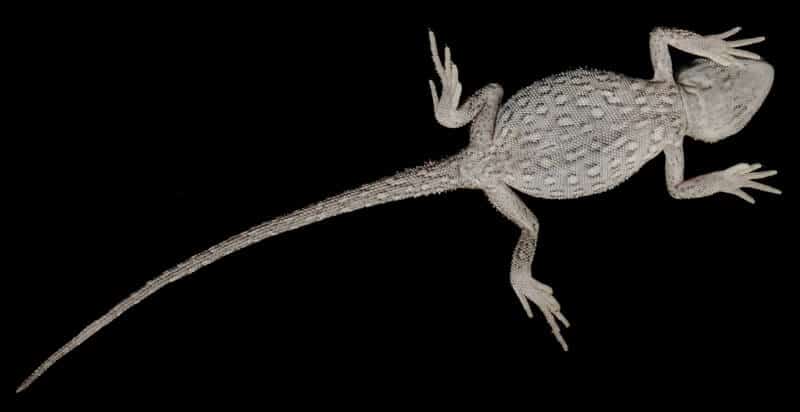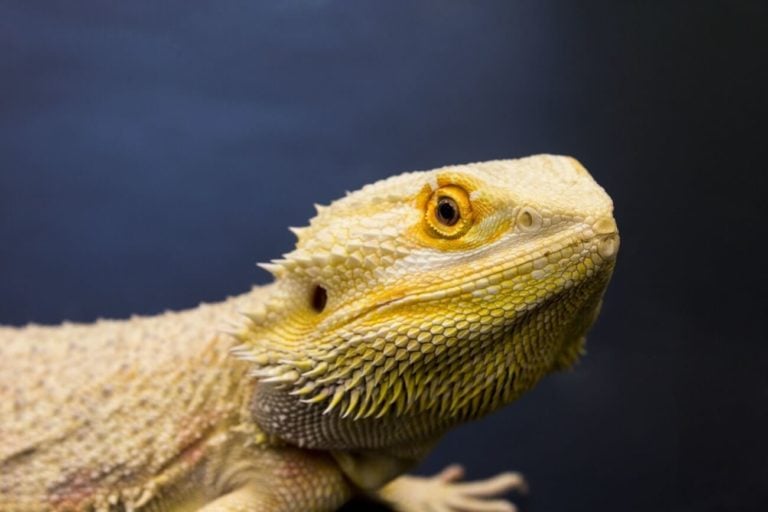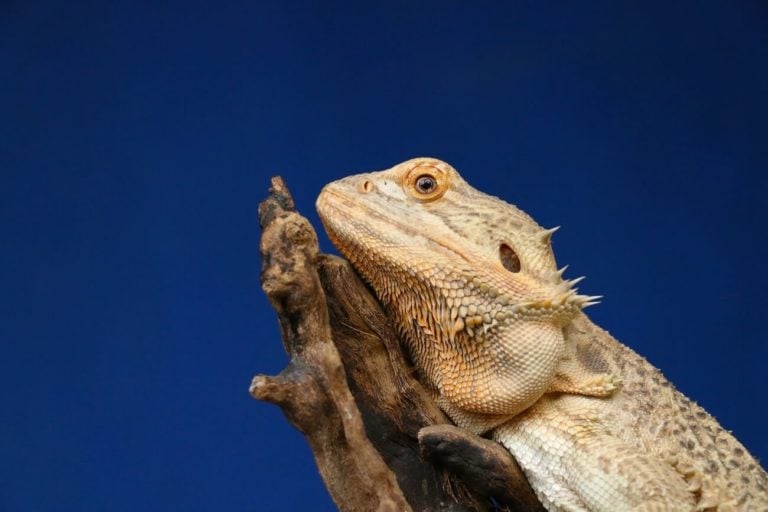Bearded dragon stress marks can appear for seemingly no apparent reason, and getting to the bottom of things as an owner can be frustrating.
But it doesn’t have to be!
This guide will help you figure out the cause of stress marks on bearded dragons, and what you can do about them.
Table of Contents
What Do Stress Marks Look Like On Bearded Dragons?
Even if you love and take good care of your bearded dragon, there will still be times when it experiences stress or feels uncomfortable. How are you, as a caretaker, supposed to know when your dragon is experiencing stress? One of the most obvious ways to tell if your beardie is upset or sick is if you begin to notice stress marks.
What are bearded dragon stress marks? They are pretty much what they sound like. When a bearded dragon feels threatened, afraid, or unwell, you’ll notice that its stomach and limbs will begin developing dark ovals or blackish, squiggly lines. In some cases, even your bearded dragon’s beard may turn black or they’ll develop little black spots.

Expert Tip: Some people compare a bearded dragon’s stress marks to the stripes on a tiger, but oval markings are just as common.
Stress marks on a bearded dragon are quite noticeable, so you’ll easily be able to tell when your pet lizard is feeling stressed out or uncomfortable. Even the faintest of markings will be very noticeable.
One thing to note is that a bearded dragon’s beard area will often appear darker right before it begins to shed. If you notice that your dragon’s beard is turning darker, wait a couple of days to see if it shows signs of shedding. This will let you know that shedding is probably the cause of this change in appearance and not something else. A trip to the vet may be needed if your bearded dragon is not shedding and you can’t find another cause.
What Causes Them?
Once you notice stress marks on your bearded dragon, the next thing to do is to figure out what could be causing them. Since there are so many reasons why your dragon could be experiencing this, you’ll need to do a bit of detective work.
To help you out, we’ve compiled a list of the most common bearded dragons stressors. With a little patience and the process of elimination, you should be able to find out the cause of your beardie’s stress marks.
Relocation Stress
Relocation is probably the most common reason for the sudden appearance of bearded dragon stress marks. Beardies can be quite sensitive to any kind of change, so their stress could be caused by something as simple as moving the enclosure from one area of your home to another.
Have you recently moved your bearded dragon into a new tank? This type of an enclosure change could be creating a sense of severe anxiety for your little pet.
If you have a new bearded dragon, the move from the store to your home may have caused it to develop stress marks. Until it gets used to its new environment, it may continue to show stress marks.
In addition to stress marks, a new bearded dragon may present other signs of stress that include a lack of appetite, abnormal stool, and lethargy. These symptoms should all pass as soon as they begin to feel at home.
Expert Tip: Don’t hesitate to call the veterinarian if your bearded dragon doesn’t seem to be adjusting and the stress marks have not gone away. There could be more than relocation stress going on.
Issues With The Tank
If there is something amiss with your bearded dragon’s living environment, then stress marks might be one way that they’ll show it. There are a few issues to keep an eye out for, so let’s take a look at each of them.
1. The Temperature In The Tank
Besides relocation, an incorrect temperature within the enclosure is probably the most common cause of bearded dragon stress marks.
You may notice that they have stress marks in the morning that fade slightly as the day progresses. This is a sign that the temperature in its tank is dropping below comfortable temperatures during the night. Making sure that the tank’s nighttime temperature stays between 70 and 75 degrees Fahrenheit will help to keep your bearded dragon nice and comfy during the night.
The next thing to check is the temperature of its basking area. Typically, the basking area should be around 20 degrees warmer than the cooler side of the temperature gradient. This means that a basking temperature of 95-100 degrees should be maintained at all times.
Use a thermal temperature gun or place thermometers inside the tank to ensure that your bearded dragon stays consistently comfortable.
2. Tank Decorations
The habitat setup in your bearded dragon’s tank could be stressing it out. Something that you might think is cute may not be so endearing to your pet. It could also be that the tank feels too crowded with objects, or the tank decor could be scratching your bearded dragon. Try removing some of the decorations to see if the stress marks go away.
3. Food Left In The Tank
After your dragon has had its fill of live feeders, it’s important to remove any that remain uneaten. Live feeders can scratch or bite your dragon. Having them running around the tank can be very traumatic for your pet.
Expert Tip: Check all nooks and crannies thoroughly because feeders will often hide.
4. Incorrect Tank Size
If you have your bearded dragon in a tank that’s not the appropriate size, then that could be what is causing stress marks. While it’s true that bearded dragons enjoy having plenty of places in which to hide, they don’t like to feel cramped. Bearded dragons enjoy having room for exploring and moving about, so a tank that is too small for them to move about comfortably will definitely stress them out.
The right size tank for a bearded dragon is about 50-55 gallons. If you can go bigger, then that’s perfectly fine. And always make sure that if you have a baby beardie in a smaller tank, you give it a larger enclosure as it grows.
5. Dirty Tank
Been a little lax about cleaning your beardie’s enclosure? Not only is a dirty habitat a breeding ground for harmful bacteria, but it will totally gross out your bearded dragon. These sweet reptiles love a clean and well-ordered tank, and this helps them to feel safe and cared for. If you notice stress marks on your bearded dragon, it’s a good idea to check the cleanliness of its enclosure.
Keeping the tank in good order will help to ensure that your little friend is happy, healthy, and well-adjusted.
6. No Place To Hide
As much as bearded dragons enjoy climbing around and exploring their tank, they also love to find a nice quiet spot to hide and relax. If your bearded dragon’s tank doesn’t have enough places to hide, or if the hiding spots are too small, then they are going to be very stressed.
You can try to either provide more appropriate hiding spots, or you can change up the ones that are already in the tank. A few simple changes could make all the difference.
Things Going On Outside The Tank
It’s important to realize that what’s going on outside the tank can be as stressful to your bearded dragon as what happens inside of it. If you have checked the tank, and nothing seems to be amiss, then the chances are pretty good that the problem lies outside of the enclosure.
1. Loud Noises
Bearded dragons don’t like loud noises and confusion. If you have young children in the home, a dog that barks a lot, or if the enclosure is near the television, then the level of noise may be the cause of the stress marks on your bearded dragon.
It’s preferable that these reptiles are housed in an area of the home that is not bombarded by constant noise. Think about how consistent noise and chaos can drive you crazy. It’s no different for your beardie. It’s important to be respectful of your pet’s feelings and tolerance of noise.
2. Being Handled Too Much
We know that your bearded dragon is adorable and super fun to hold and spend time with. However, too much handling (as well-intentioned it may be) is often a source of stress for them. Playing with your dragon is a great way for you to develop a relationship with your pet, but you will need to be respectful of how much your dragon likes to be handled.
If it shows signs of stress or stress marks after you take it out of its tank, then just try handling it less often or for a shorter period of time.
3. They’re Bored
Bearded dragons, like many pet reptiles, need lots of stimulation. This means that they like to have plenty of places to explore, things to climb on, and toys to play with.
A well thought out enclosure will contain everything that your bearded dragon needs to stay entertained and engaged. If you suspect that your beardie is breaking out in stress marks from a lack of stimulation, then invest in some fun toys or games, or you can take your dragon out of its tank for some one on one play time.
4. They Want To Cuddle
Even though your bearded dragon may not appreciate too much handling, they certainly do like to spend time with you. Stress marks on a bearded dragon can sometimes be its way of telling you that it’s not getting enough attention. If you haven’t cuddled with your bearded dragon in a while, then take it out of its tank and give it some extra love.
5. A Few Other Things To Consider
There really are so many other reasons why your dragon may be experiencing stress. It could be stressed out by seeing its own reflection in the tank’s glass, it could be going through mating season, or it may be having issues with another bearded dragon.
Like we said earlier, discovering the cause of the stress marks you’re seeing on your bearded dragon is a process of elimination. Don’t hesitate to give your pet’s veterinarian a call if you are not able to figure it out. It could be that your bearded dragon is ill or needs extra care.
How Long Will They Last?
While finding stress marks on your bearded dragon may be upsetting, they are almost always not a cause for serious concern. They usually don’t last long and tend to disappear along with the stressor.
How long the stress marks stick around typically depends on why they appeared in the first place. If it’s early in the morning, and the temperature in your bearded dragon’s enclosure dropped too low, then they may develop a few faint stress marks until their body temperature increases.
If it’s something environmental, then the stress marks will most likely last until the issue causing the stress is fixed. However, there are cases when the stress marks remain even after all possible causes have been dealt with. For stress marks that last a long time or seem to get worse, we recommend taking your bearded dragon to the vet’s office right away.
The duration of stress marks on a baby beardie is harder to predict because they often appear without reason and can last until adulthood. If you are concerned, or if you notice severe symptoms, then a visit to the vet is the right move.
How To Get Rid Of Bearded Dragon Stress Marks
Even though stress marks aren’t dangerous in and of themselves, they are still a sign that something is troubling your bearded dragon. Trying to find the source of your dragon’s distress is going to be the first and most important step. Once you deal with what was upsetting your pet, it could still be a while before the stress marks fade completely away.
In addition to finding the cause of the stress marks, there are some additional things that can be done to make your bearded dragon happier and less bothered. We’ll go over a few of the actions you can try. However, be aware that the effectiveness of these methods often depends on whether you’ve had your dragon for a while, or if it is new to your home.
If your beardie is used to you, and you have developed a bond of trust, then try taking it out of its tank for a bit of a cuddle. Holding your dragon and speaking gently to it in a soft voice can go a long way towards helping it to feel less stressed. This technique could backfire with a new beardie though, so see how it reacts to your advances before trying this method.
Another way to bring a sense of peace to your bearded dragon is to give it a warm bath. Again, this is a calming technique that is better suited to a beardie that has been in your care for a while. While a warm bath and a cuddle afterwards will work with many bearded dragons, it can sometimes cause more stress. Take things slowly and be sensitive to how they are responding to the bath.
Other things to try include dimming the lights within the enclosure for a short period of time, gently stroking your bearded dragon while it’s in its enclosure, or you can give it a special treat of its favorite fruits or vegetables.
Expert Tip: Once you develop a rapport with your bearded dragon, then you will have a better sense of what will calm it down. Every animal is different, so have lots of patience, be gentle, and show it plenty of love. Remember that your bearded dragon relies on you for all of its physical and emotional needs, so finding the right solution is going to be an important part of your relationship.
Is It Possible For Baby Bearded Dragons To Get Stress Marks?
When it comes to developing stress marks, beardie babies are no different than adults. The duration of their stress marks and the reasons behind them may vary slightly from those of adult bearded dragons, but they look pretty much the same.
Perhaps the most common cause of stress marks in baby bearded dragons is relocation. We’re sure that you can imagine how stressful it is for a baby bearded dragon to be taken away from everything that feels familiar and safe, only to find itself in a place full of strange smells, sounds and faces. If you have a new baby bearded dragon, and it has developed stress marks, then they should go away as soon as your beardie adjusts to its surroundings.
There may be times that your baby dragon may develop stress marks for no obvious reason. If you’ve determined that the stress marks are not caused by anything serious, then the only thing to do is to wait until they fade. This could take a few days or even a few months.
Conclusion
Bearded dragon stress marks can be concerning (especially if you’re a new owner), but most of the time it’s not a serious problem. Simply refer to this guide to diagnose the cause, and fix it!
If you have any other questions about stress marks on your beardie, let us know. And of course, you should never feel bad about contacting your vet if you see symptoms that concern you.


